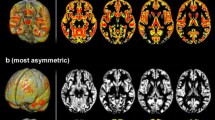Abstract
Results from analyses of sex ratios as a function of IQ are presented for 623 autistic children (487 males, 136 females) and 506 nonautistic, communication-handicapped and behavior-disordered children (374 males, 132 females). Proportionately more autistic females were found to have IQs of 34 or below than above 34. However, a linear trend of an increasing number of males with increasing intelligence was found only for nonautistic subjects. The relevance of these findings to genetic factors and the heterogeneity of autism is discussed.
Similar content being viewed by others
References
August, G. J., Stewart, M. A., & Tsai, L. (1981). The incidence of cognitive disabilities in the siblings of autistic children.British Journal of Psychiatry, 138, 416–422.
Baker, L., & Cantwell, D.P. (1982). Language acquisition, cognitive development, and emotional disorder in childhood. In K. E. Nelson (Ed.),Children's language (Vol. 3) (pp. 286–321). Hillsdale, New Jersey: Erlbaum.
Bartak, L., & Rutter, M. (1976). Differences between mentally retarded and normally intelligent autistic children.Journal of Autism and Childhood Schizophrenia, 6, 109–120.
Carter, C. O. (1969). An ABC of medical genetics: VI. Polygenic inheritance and common diseases.Lancet, 1, 1252–1256.
Cloninger, C. R., Christiansen, K. O., Reich, T., & Gottesman, I. (1978). Implications of sex differences in the prevalence of antisocial personality, alcoholism and criminality for familial transmission.Archives of General Psychiatry, 35, 941–951.
Daykin, E., & MacMahon, B. (1979). The incidence of seizures among children with autistic symptoms.American Journal of Psychiatry, 136, 1310–1312.
Fein, D., Waterhouse, L., Lucci, D., & Snyder, D. (1983, February).Cognitive Subtypes in infantile autism. Paper presented at the meeting of the International Neuropsychological Society, Mexico City.
Folstein, S., & Rutter, M. (1977). Infantile autism: A genetic study of 21 twin pairs.Journal of Child Psychology and Psychiatry, 18, 297–321.
Freeman, B. J., Ritvo, E. R., Schroth, P. C., Tonick, I., Guthrie, D., & Wake, L. (1981). Behavioral characteristics of high and low I.Q. autistic children.American Journal of Psychiatry, 138, 25–29.
Freire-Maia, A., Freire-Maia, N., & Morton, N. E. (1974). Sex effect on intelligence and mental retardation.Behavior Genetics, 4, 269–272.
Gillberg, C., & Gillberg, I. C. (1983). Infantile autism: A total population study of reduced optimality in the pre-, peri-, and neonatal periods.Journal of Autism and Developmental Disorders, 13, 153–166.
Gottesman, I. I., Shields, J., & Hanson D. (1982).Schizophrenia: The epigenetic puzzle. New York: Cambridge University Press.
Hanson, D. R., & Gottesman, I. I. (1976). The genetics, if any, of infantile autism and childhood schizophrenia.Journal of Autism and Childhood Schizophrenia, 6, 209–234.
Lord, C. (1984). On the differences between the sexes [Letter to the editor].Journal of Autism and Developmental Disorders, 14, 212–214.
Lord, C., Schopler, E., & Revicki, D. (1982). Sex differences in autism.Journal of Autism and Developmental Disorders, 12, 317–330.
Lotter, V. (1966). Epidemiology of autistic conditions in young children. 1. Prevalence.Social Psychiatry, 124–137.
Minton, J., Campbell, M., Green, W. H. Jennings, S., & Samit, C. (1982). Cognitive assessment of siblings of autistic children.Journal of the American Academy of Child Psychiatry, 21, 256–261.
Reich, T., Cloninger, C. R., & Guze, S. B. (1975). The multifactorial model of disease transmission: 1. Description of the model and its use in psychiatry.British Journal of Psychiatry, 127, 1–10.
Rieder, R. O., & Gershon, E. S. (1978). Genetic strategies in biological psychiatry.Archives of General Psychiatry, 35, 866–873.
Ritvo, E. R., Ritvo, C., & Brothers, A. M. (1982). Genetic and immunohematologic factors in autism.Journal of Autism and Developmental Disorders, 12, 109–114.
Rutter, M. (1978). Diagnosis and definition. In M. Rutter & E. Schopler (Eds.),Autism: A reappraisal of concepts and treatment (pp. 1–26). New York: Plenum.
Rutter, M. (1984). Infantile autism: Assessment, differential diagnosis and treatment. In D. Shaffer, A. Erdhard, & L. Greenhill (Eds.),A clinician's guide to child psychiatry. New York: Free Press.
Schopler, E., Reichler, R., DeVellis, R., & Daly, K. (1980). Toward objective classification of childhood autism: Childhood autism rating scale (CARS).Journal of Autism and Developmental Disorders, 10, 91–103.
Siegal-Gorelick, B. (1983).Research on empirical sub-classification of children with autism. Paper presented at the annual meeting of the National Society for Adults and Children with Autism, Salt Lake City.
Tanguay, P. (1984). Toward a new classification of serious psychopathology in children.Journal of the American Academy of Child Psychiatry, 23, 373–384.
Tsai, L., & Beisler, J. M. (1983). The development of sex differences in infantile autism.British Journal of Psychiatry, 142, 373–378.
Tsai, L., Stewart, M. A., & August, G. (1981). Implication of sex differences in the familial transmission of infantile autism.Journal of Autism and Developmental Disorders, 11, 165–174.
Wing, L. (1981a). Sex ratios in early childhood autism and related conditions.Psychiatry Research, 5, 129–137.
Wing, L. (1981b). Language, social, and cognitive impairments in autism and severe mentalretardation.Journal of Autism and Developmental Disorders, 11, 31–44.
Wing, L. (1984). Some questions on sex differences [Letter to the editor].Journal of Autism and Developmental Disorders, 14, 212.
Wing, L., & Gould, J. (1979). Severe impairments of social interaction and associated abnormalities in children: Epidemiology and classification.Journal of Autism and Developmental Disorders, 9, 11–29.
Wittig, M. A. (1979). Genetic influences on sex-related differences in intellectual performance: Theoretical and methological issues. In M. A. Wittig & A. C. Petersen (Eds.),Sex related differences in cognitive functioning (pp. 21–63). New York: Academic Press.
Author information
Authors and Affiliations
Additional information
This research was conducted using data provided by Division TEACCH, Department of Psychiatry, University of North Carolina, Chapel Hill. Thanks are due to Bob McConnaughey for help with computer programming. Support from the Alberta Heritage Fund for Medical Research made this research possible. Suggestions made on an earlier draft of this manuscript by Susan Folstein, Irving Gottesman, and Lorna Wing were much appreciated.
Rights and permissions
About this article
Cite this article
Lord, C., Schopler, E. Brief report: Differences in sex ratios in autism as a function of measured intelligence. J Autism Dev Disord 15, 185–193 (1985). https://doi.org/10.1007/BF01531604
Issue Date:
DOI: https://doi.org/10.1007/BF01531604




